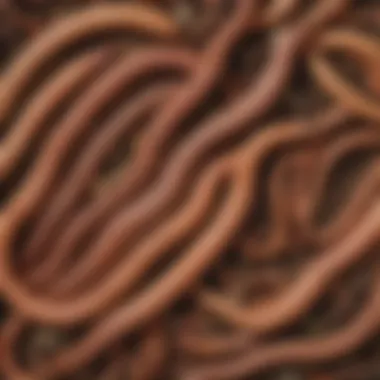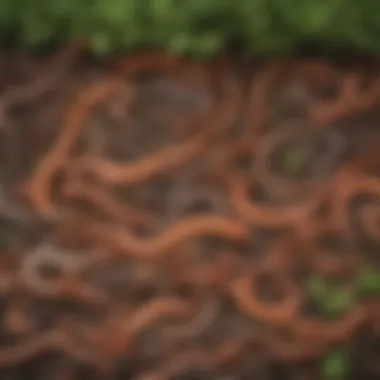Discover the Ideal Diet for Earthworms: A Complete Guide


Discover the Wonders of Science
Earthworms, fascinating creatures that they are, have a surprisingly intricate relationship with their diet. LabLittles delves deep into the dietary preferences of these soil-dwelling wonders, shedding light on the optimal feeding practices that lead to their thriving existence. From the selection of organic materials to the eco-conscious considerations, this detailed guide is designed to educate and engage the curious minds of elementary school children, as well as enlighten the ever-caring parents and caregivers who seek to provide the best for their earthworm companions. Let us embark on this enlightening journey of nourishment and sustenance for our subterranean friends.
Science Fun Facts
In the realm of earthworm lore, did you know that these humble creatures are key players in the decomposition process of organic matter? Their voracious appetites and remarkable digestive systems break down dead plant material, releasing vital nutrients back into the soil. Moreover, earthworms have been known to live up to 10 years in captivity, showcasing their resilience and importance in maintaining soil health. As we unravel the mysteries of what makes earthworms tick, we find ourselves in awe of their contributions to the ecosystem.
Interesting Trivia and Facts
Earthworms have five pairs of hearts, pumping their colorless blood throughout their bodies. Surprisingly, they breathe through their skin, absorbing oxygen directly from the air, making them particularly susceptible to environmental changes. In fact, some cultures consider earthworms a symbol of good luck and fertility, attributing mystical qualities to these humble creatures.
Environmental Considerations and Dietary Choices
In a world increasingly focused on sustainability and eco-friendliness, understanding the environmental impact of our actions is paramount. LabLittles highlights the importance of choosing organic materials for feeding earthworms, emphasizing the role that our dietary choices play in their well-being and the health of our planet. By opting for kitchen scraps, shredded paper, and other biodegradable items, we not only provide nutritious meals for our earthworm friends but also reduce the burden on landfills and contribute to a more harmonious ecosystem.
Real-Life Applications of Science
By exploring the dietary preferences of earthworms, we gain insight into broader scientific concepts such as decomposition, nutrient cycling, and soil health. This knowledge is not only informative but also applicable in real-life scenarios, encouraging children to think critically about their actions and the interconnectedness of the natural world. As we feed our earthworm companions, we nourish not only their bodies but also our minds, fostering a deeper appreciation for the wonders of science that surround us.
Let's embark on this educational journey together, unraveling the mysteries of earthworm diet and environmental conscientiousness with LabLittles as our guide.
Introduction


In the bustling world of earthworms, understanding their dietary preferences is paramount to their well-being. This article delves deep into the intricate world of earthworms, shedding light on the importance of providing these creatures with a diet that caters to their unique needs. By exploring the optimal feeding practices for earthworms, LabLittles aims to enlighten readers on the significance of proper nutrition for these fascinating organisms. Through a lens of curiosity and learning, this guide will navigate through the depths of earthworm diets, uncovering essential details for nurturing these tiny yet essential organisms.
Understanding Earthworms
Anatomy and Habitats
Earthworms, with their simplistic yet efficient bodies, are masters of their underground dwellings. The segmented bodies of these wriggling creatures play a crucial role in aiding their movement through the soil. Their habitats, often dark and moist, provide the ideal environment for these underground pioneers to thrive. By understanding the anatomy of earthworms, one can appreciate how their physical characteristics align perfectly with their subterranean lifestyle. This section will explore the unique adaptations that make earthworms resilient inhabitants of the soil ecosystem, shedding light on the marvels of their simple yet effective anatomical features.
Role in Ecosystems
Earthworms aren't just humble inhabitants of the soil; they are the unsung heroes of ecosystems. Their tireless burrowing activities aerate the soil, facilitating better water infiltration and root growth. By decomposing organic matter, earthworms enrich the soil with essential nutrients, playing a vital role in sustaining plant life. This section will delve into the intricate web of interactions that earthworms participate in within ecosystems, showcasing their significant contributions to maintaining soil health and promoting biodiversity.
Importance of Feeding Earthworms
Nutritional Needs
The nutritional needs of earthworms are not to be underestimated. These tiny creatures require a balanced diet rich in organic materials to fuel their metabolic processes. By understanding the nutritional requirements of earthworms, one can ensure their optimal growth and reproduction. This section will highlight the key nutrients that earthworms need to thrive, shedding light on the importance of providing them with a varied and nutrient-rich diet.
Impact on Soil Health
Feeding earthworms is not just about nourishing them; it's about nurturing the very foundation of life – soil. The action of earthworms on organic matter influences soil structure, porosity, and nutrient availability. By feeding earthworms appropriately, one can promote soil health and fertility, creating a harmonious environment for plant growth. This section will explore the profound impact that feeding earthworms has on soil health, emphasizing the symbiotic relationship between these humble creatures and the earth they inhabit.
Optimal Earthworm Die
Understanding the significance of an optimal diet for earthworms is fundamental to their well-being. In the realm of earthworm care, providing the right nutrition is key to fostering a thriving worm community. It directly influences their health, reproduction rates*, and overall ecosystem benefits. By focusing on an optimal earthworm diet, individuals can play a vital role in contributing to the sustainability of their surroundings. The essence of the optimal earthworm diet lies in the meticulous selection and balance of organic materials. Ensuring that earthworms receive a varied diet rich in essential nutrients is paramount for their growth and development #O nic Materials## W n the spectrum of organic materials, fruit and vegetable scraps emerge as standout choices for earthworm feeding. The decomposable nature* of these scraps not only provides earthworms with a sustainable food source but also enriches the soil with valuable nutrients. Their high moisture content and easy breakdown in the vermicomposting process make them highly sought-after options. Furthermore, fruit and vegetable scraps serve as an ideal medium for fostering microbial activity within the worm bins, promoting a healthy environment conducive to earthworm growth and reproduction Characteristics### Cof rounds and tea leaves are prized additions to the earthworm diet due to their dual purpose: nourishment and soil enrichment. Their acidic properties aid in balancing the pH levels within the vermicomposting system, creating an optimal environment for worm activity. An additional benefit stems from their texture, which aids in aerating the soil and enhancing drainage. The presence of essential minerals within coffee grounds and tea leaves further accentuates their value, contributing to the overall well-being of earthworms & Eggshells and grit constitute essential components of the earthworm diet, offering a multifaceted approach to calcium supplementation and digestion enhancement. Eggshells, being rich in calcium, support the development of earthworm cocoons and maintain soil pH levels. Grit, on the other hand, aids in the mechanical breakdown of organic matter in the worm's digestive system. Together, they play pivotal roles in ensuring the vitality and longevity of earthworm populations## Avoiding mful Foods## While earth s are versatile eaters, some foods may prove detrimental to their well-being. Citrus fruits fall under this category due to their high acidity levels, which can disrupt the pH balance in the worm bins. This imbalance may hinder the vermicomposting process and compromise the overall health of earthworms. By excluding citrus fruits from their diet, individuals can maintain a harmonious environment conducive to worm activity### Spicy or salt ds, although enticing to human taste buds, are unsuitable for earthworm consumption. Spices and salts can irritate earthworms' delicate skin and suppress microbial activity within the vermicomposting system. Additionally, the presence of such substances can alter the soil composition* in undesirable ways, potentially affecting earthworm growth and reproduction negatively## Dairy products, de e their nutritional value to humans, pose challenges when included in the earthworm diet. The high protein and fat content in dairy products can lead to putrefaction in worm bins, emitting foul odors and attracting pests. Moreover, dairy products can be difficult for earthworms to digest efficiently, leading to potential health issues. Thus, omitting dairy products from the earthworm diet is crucial for maintaining a balanced and thriving vermicomposting ecosystem


Feeding Techniques
Feeding techniques form a crucial aspect of understanding the dietary requirements of earthworms in the ecosystem. Proper feeding practices contribute significantly to the overall health and well-being of these fascinating creatures. LabLittles sheds light on the specific elements that ensure the optimal feeding of earthworms. By focusing on key considerations such as the types of organic materials, quantities, and frequencies, this section highlights the pivotal role feeding techniques play in creating a sustainable environment for earthworms to thrive.
Composting with Earthworms
Vermicomposting Basics
Vermicomposting basics delve into the fundamental principles of utilizing earthworms in composting organic materials. This technique offers a natural and efficient way to recycle kitchen scraps and garden waste, minimizing environmental impact. One key characteristic of vermicomposting basics is its ability to accelerate the decomposition process through the digestive activities of earthworms. This method is a popular choice for LabLittles' comprehensive guide due to its sustainability and versatility. The unique feature of vermicomposting basics lies in the production of nutrient-rich compost that enhances soil fertility, a crucial advantage for promoting healthy plant growth.
Creating a Healthy Habitat
Creating a healthy habitat for earthworms is essential for their well-being and productivity within a composting system. This aspect contributes significantly to the overall goal of maintaining a balanced ecosystem. The key characteristic of creating a healthy habitat involves providing suitable bedding materials and ensuring proper moisture levels for earthworm activity. LabLittles emphasizes the importance of this practice as it promotes earthworm reproduction and enhances the efficiency of vermicomposting. While the unique feature of creating a healthy habitat lies in fostering a symbiotic relationship between earthworms and microorganisms, the advantages include improved compost quality and reduced chances of pests infestation.
Frequency and Quantity
Balanced Feeding Practices
Balanced feeding practices are integral to sustaining a healthy population of earthworms in a composting environment. This approach focuses on meeting the nutritional needs of earthworms without overwhelming them with excess food. LabLittles highlights the key characteristic of balanced feeding practices, which involves offering a varied diet composed of different organic materials to ensure a diverse nutrient intake. This method is a beneficial choice for the article as it promotes efficient waste decomposition and nutrient recycling. The unique feature of balanced feeding practices is the promotion of a stable ecosystem within the vermicomposting system, leading to enhanced soil health and plant growth.
Monitoring Consumption
Monitoring consumption plays a vital role in ensuring the optimal feeding habits of earthworms are maintained over time. This practice allows for the assessment of feeding rates, food preferences, and overall health of the earthworm population. LabLittles accentuates the importance of this aspect as it contributes to adjusting feeding regimes and detecting any potential issues promptly. The key characteristic of monitoring consumption lies in observing earthworm behavior and waste breakdown patterns to gauge their nutritional requirements accurately. This method is a popular choice for the article due to its ability to prevent overfeeding and create an optimal environment for earthworms to thrive. The advantages of monitoring consumption include efficient resource utilization and a reduced likelihood of habitat contamination.


Environmental Considerations
When delving into the realm of earthworm care, one cannot overlook the crucial aspect of environmental considerations. These considerations play a fundamental role in the well-being and sustainability of earthworm habitats. In this section, we will explore the significance of maintaining ideal environments for earthworms to thrive.
Temperature and Moisture
Ideal Conditions
One of the key determinants of a suitable earthworm habitat is maintaining ideal conditions in terms of temperature and moisture. Ideal conditions refer to the perfect balance of warmth and wetness that fosters optimal earthworm activity. The ideal temperature ensures that earthworms remain active and productive, while the right moisture level sustains their overall health. Achieving this delicate equilibrium is vital for the well-being of earthworms in the ecosystem. It supports their growth, reproduction, and contribution to soil quality.
In the context of this article, highlighting the ideal conditions provides valuable insights into creating a conducive environment for earthworms. The unique feature of ideal conditions lies in their ability to maximize earthworm efficiency and encourage beneficial behaviors. These conditions offer a plethora of advantages, including enhanced nutrient recycling, improved soil aeration, and heightened soil fertility. By optimizing ideal conditions, earthworm caregivers can experience higher vermicomposting yields and healthier soil ecosystems.
Preventing Mold and Rot
Furthermore, preventing mold and rot constitutes a critical aspect of earthworm care within the realm of environmental considerations. Mold and rot can pose significant threats to earthworms' well-being and habitat sustainability. By addressing this concern, caregivers can ensure a safe and hygienic environment for their earthworm colonies. Preventing mold and rot involves controlling moisture levels, implementing proper aeration, and regularly monitoring the composting process.
In the context of this article, emphasizing the importance of preventing mold and rot sheds light on proactive strategies to safeguard earthworm health. The distinctive feature of this practice lies in its ability to mitigate risks associated with fungal growth and organic matter decomposition. Its advantages include promoting a clean and conducive habitat for earthworms, reducing the likelihood of disease transmission, and maintaining overall ecosystem balance.
Storage and Placement
Proper Containers
Selecting proper containers for housing earthworms is a pivotal consideration in ensuring their well-being and productivity. Proper containers should offer ample space for earthworm movement, adequate drainage to prevent waterlogging, and suitable ventilation for airflow. These containers come in various sizes and materials, each catering to different needs and preferences. Opting for the right container type can significantly impact the comfort and efficiency of earthworm colonies.
In the context of this article, focusing on proper containers highlights the essence of providing a safe and spacious living environment for earthworms. The unique feature of proper containers lies in their ability to promote optimal earthworm activity and reproduction. Choosing the right containers offers multiple advantages, such as minimizing stress on earthworms, facilitating waste processing, and enhancing vermicomposting outcomes.
Indoor vs. Outdoor Considerations
The decision between indoor and outdoor settings for earthworm habitats influences their care routines and environmental impact. Indoor setups provide controlled conditions, protection from extreme weather, and ease of monitoring, making them suitable for year-round earthworm maintenance. Conversely, outdoor placements offer natural light exposure, access to diverse organic materials, and increased space for larger earthworm populations.
In the context of this article, contrasting indoor and outdoor considerations sheds light on the pros and cons of each setting. The distinct feature of this comparison lies in highlighting the different advantages and disadvantages associated with indoor and outdoor environments for earthworms. Understanding these factors aids caregivers in selecting the most appropriate habitat setup based on their specific needs and available resources.







